2019年中考英语语法复习---非谓语动词 课件 (共83张PPT)
文档属性
| 名称 | 2019年中考英语语法复习---非谓语动词 课件 (共83张PPT) | 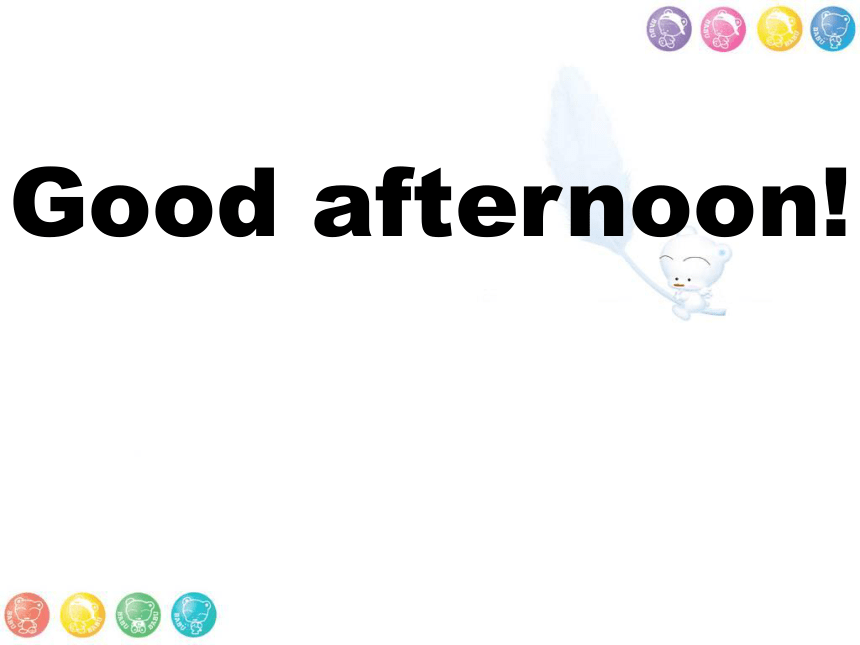 | |
| 格式 | ppt | ||
| 文件大小 | 725.0KB | ||
| 资源类型 | 教案 | ||
| 版本资源 | 通用版 | ||
| 科目 | 英语 | ||
| 更新时间 | 2019-04-07 11:10:17 | ||
图片预览


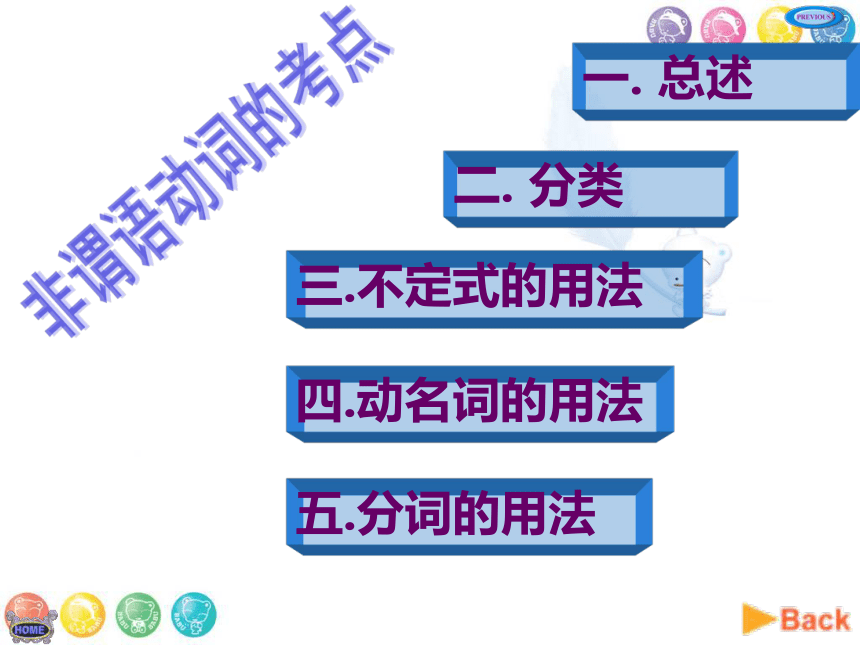

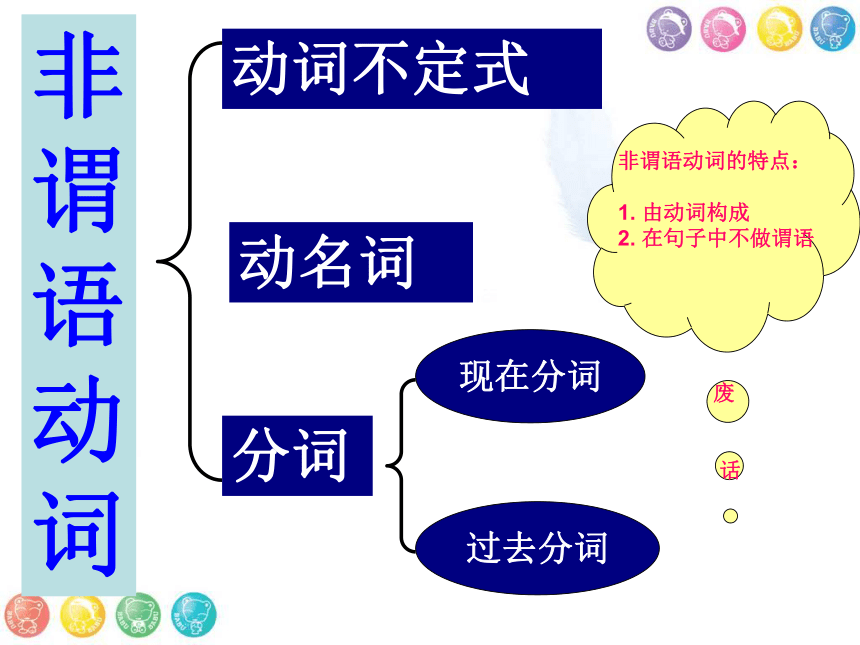
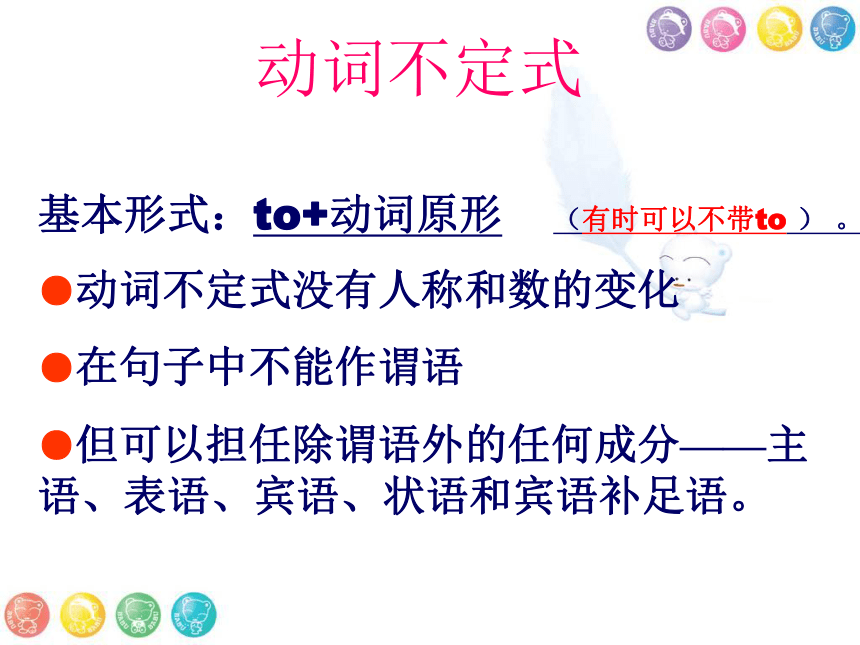
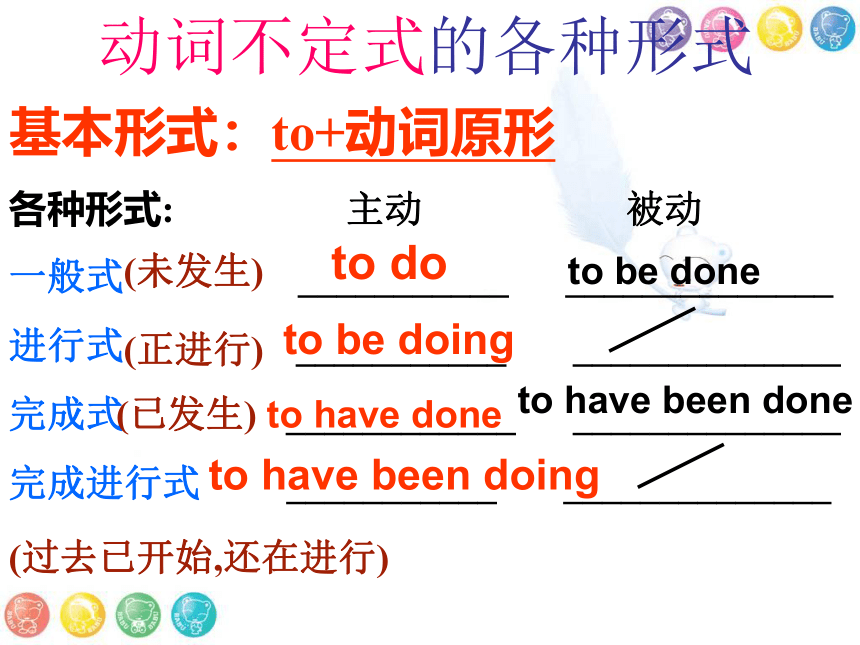

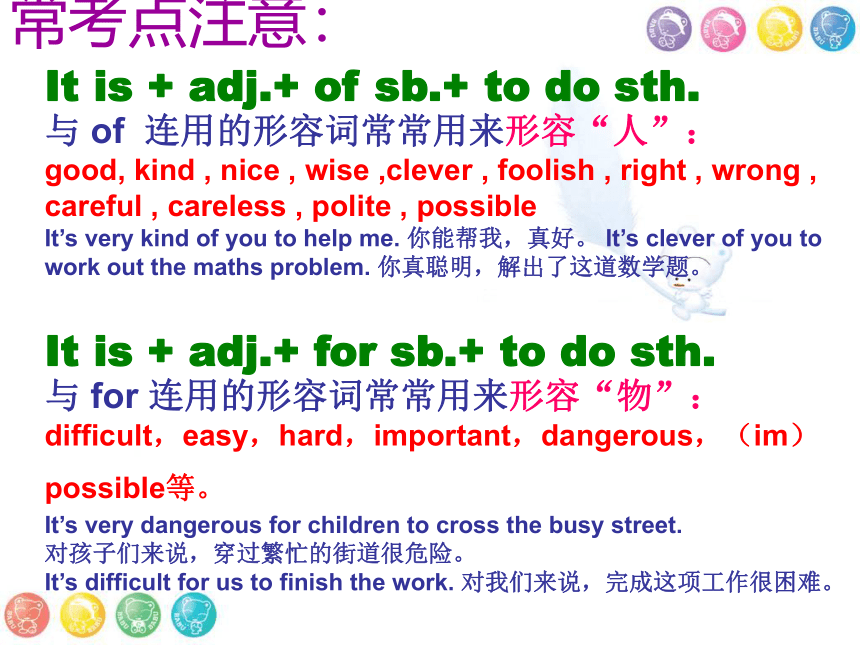



文档简介
(共83张PPT)
Good afternoon!
一. 总述
四.动名词的用法
二. 分类
五.分词的用法
三.不定式的用法
动词
谓语动词
非谓语动词
还记得,动词第一讲时:
我们将动词按形式,划分为两类
谓语动词就是能在句子中作谓语的动词(独立做谓语,或者构成复合谓语皆可)
谓语动词就是不能在句子中作谓语的动词
非谓语动词
动词不定式
动名词
现在分词
分词
过去分词
非谓语动词的特点:
1. 由动词构成
2. 在句子中不做谓语
废
话
基本形式:to+动词原形 (有时可以不带to ) 。
●动词不定式没有人称和数的变化
●在句子中不能作谓语
●但可以担任除谓语外的任何成分——主语、表语、宾语、状语和宾语补足语。
动词不定式
基本形式:to+动词原形
各种形式: 主动 被动
一般式 ___________ ______________
进行式 ___________ ______________
完成式 ____________ ______________
完成进行式 ___________ ______________
to be done
to be doing
to have done
to have been doing
to do
to have been done
(未发生)
(正进行)
(已发生)
(过去已开始,还在进行)
动词不定式的各种形式
动词不定式的句法功能
一:作主语
To learn English well is not easy.
但是,为了避免头重脚轻,常用“ it ”作形式主语,吧真正的主语(动词不定式短语)放到后面。
It is not easy to learn English well.
It is + adj.+ of sb.+ to do sth.
与 of 连用的形容词常常用来形容“人”:
good, kind , nice , wise ,clever , foolish , right , wrong , careful , careless , polite , possible
It’s very kind of you to help me. 你能帮我,真好。 It’s clever of you to work out the maths problem. 你真聪明,解出了这道数学题。
It is + adj.+ for sb.+ to do sth.
与 for 连用的形容词常常用来形容“物”:difficult,easy,hard,important,dangerous,(im)possible等。
It’s very dangerous for children to cross the busy street.
对孩子们来说,穿过繁忙的街道很危险。
It’s difficult for us to finish the work. 对我们来说,完成这项工作很困难。
常考点注意:
动词不定式的句法功能
二:作表语
动词不定式(短语)常用于系动词be的后面作表语。
His work is to drive a car.
My job is to feed animals.
动词不定式的句法功能
三:作宾语
动词不定式(短语)可以放在一些动词后面作宾语。
这些动词很关键!
在一些动词的后面,只允许接不定式作宾语:
后面只能接不定式作宾语的动词有:
三个希望两答应 hope,wish,want,agree,promise
两个要求莫拒绝 ask,demand,refuse
设法学会做决定 manage,learn,decide
不要假装在选择 pretend,choose
提供帮助的计划 offer,help,plan
预期失败要发生 expect,fail,happen
看似都接不定式 seem
四:不定式作宾语补足语
1)不可省略to的:
2)可省略to的:
3)可以省可以不省的:
(1)动词后的宾补,不可以省略不定式符号to的:
tell / ask / want / would like / wish / like / invite / encourage / teach + sb. to do sth.
I want you to go now.
His parents wish her to be a teacher.
(2) 动词后的宾补,需要省略不定式符号to的动词:
一感 feel
二听 hear,listen to
三使 make,let,have
The boy made the baby cry.
四看 notice,observe,see,watch I saw him play football on the playground yesterday.
# 注意:变为被动语态时,不定式短语从宾语补足语变为主语补足语,to还要重现到动词原形前。
例:The boy made the baby cry. (主动语态省略to)
The baby was made to cry by the boy. (被动语态:宾补变主补,to 要加回来)
特殊短语:
would rather + do
had better + do
( 3 ) .作宾补时,省略不定式符号to或不省略均可的动词:
help sb. to do sth. & help sb. do sth.
例:I often help my mother (to) do housework.
the food to live ______
the bus to come here ____
the pen to write _____
the room to live ____
the knife to cut _____
the person to write ____
on
on
with
in
with
about
五:不定式作定语
不定式作定语的基本条件
不定式与它所修饰的名词在逻
辑上必须具备以下条件之一:
1. 主谓关系
2. 动(介)宾关系
3. 说明所修饰词的内容
多为抽象名词或序数词
分析下列句子
He has a lot of work to do.
He is the right person to do it.
It’s the best way to learn English.
主谓
动宾
说明内容
表原因(原因状语):
I’m sorry to trouble you.
2.表目的(目的状语):
I went to the library to learn English.
五:不定式作状语
动词不定式
表将来
表目的
表某一次具体的动作
表示将来:
I have a lot of work to do.
2.表示某一次具体的动作:
I like dancing, but I don’t like to dance today.
3. 表示目的:
To learn English well, you must practise more.
先看几个例句,判断不定式在句中的成分。
1.To learn a foreign language is difficult . 2. His wish is to be a driver . 3.Tom wanted to have a cup of beer . 4.The teacher told us to do morning exercises . 5.I have nothing to say . 6.They went to see their aunt . 7.It’s easy to see their aunt. 8.I don’t know what to do next . 9.I heard them make a noise .
1. “to” 是不定式符号还是介词,下列短语中的to 都是介词。 agree to,object to,close to , come to , lead to , refer to ,equal to , familiar to , point to , thank to , devote to , next to , belong to ,
be(get) used to 习惯于,
look forward to 渴望,
pay attention to 注意,
get down to 开始认真(做某事),
devote oneself to 献身于
2. 带to 还是不带to I have no choice but to give in. I cannot do anything but give in. I saw him enter the classroom . ( 但是: He was seen to enter the classroom .)
不定式的常考点:
3、不定式的否定形式:not to do sth.
例如:Tell him ___ the window.
A. to shut not B. not to shut C. to not shut D. not shut 答案:B. tell sb to do sth 的否定形式为tell sb not to do sth.
4、动词不定式与疑问词连用:疑问代词who, what, which和疑问副词 when, where, how , why等后面可以按动词不定式,构成动词不定式短语,可以在句子中作主语、宾语、表语等成分。
例如:
(1) He doesn’t know how to use the machine. (不定式作宾语)
(2) How to use the machine is a question. (不定式作主语)
(3) The question is when to go there. (不定式作表语)
不定式的常考点:
5、不定式的特殊句型:
1)too…to…:太…而不能…
He is too excited to speak.
2)enough to do:足以做 …
The child is old enough to go to school.
3) " Why not +动词原形"表达向某人提出建议,翻译为:"为什么不…… "
Why not take a holiday
4)so as (not) to do: 表示目的
Go in quietly so as not to wake the baby.
不定式的常考点:
动名词
动词的-ing形式用作动名词:
● 由动词原形加-ing构成
● 它在句中起名词的作用
● 可以在句子中用作主语、表语、宾语、宾语补语、状语和定语。
动 名 词
动名词的特点:
① 抽象
② 习惯性
His hobby is painting.
I’m proud of being a Chinese.
习惯
抽象
Learning English is very difficult . 学英语非常困难。 His job is driving a bus . 他的工作是开车。 I enjoy dancing . 我喜欢跳舞。 I have got used to living in the country . 我已经习惯了住农村。 Take some sleeping tablets , and you will soon fall asleep . 吃点安眠药,你很快就会入睡。
主 动 被 动
一般式 doing being done
完成式 having done having been done
语态
时态
动名词的时态和语态
1)动名词作主语 Walking is good exercise. 走路是很好的运动。
2)动名词作表语 My favorite sport is swimming. 我最喜欢的运动是游泳。
动名词的句法功能(4点)
3) 动名词作宾语 Jim dislikes eating chocolate. 吉姆不喜欢吃巧克力。 She can’t help crying at a sad movie. 她看了忧伤的电影禁不住要哭。
[说明] 有些动词和动词短语后只能接动名词作宾语。
例如:admit, finish, forgive, give up, mind, practise, be good at, do well in, can't help, keep on, feel like, be used to, look forward to, prefer to,等。
动名词的句法功能
有些动词只能接动名词作宾语,(动宾)
如: appreciate, avoid, consider (考虑), enjoy, finish, imagine, keep, mind, miss, practice, suggest (建议)……
还有些短语动词以一介词结尾,也只能接动名词作宾语(尤其是介词to易出错):(介宾)
如:depend on…, insist on…, feel like…, be used to (习惯于)…, look forward to…, devote to…, pay attention to...
动名词的句法功能
有些动词只能接动名词作宾语 ( 31个):
放弃享受可原谅 give up,enjoy,excuse/ pardon / forgive
保持练习必完成 keep,practice,finish
鼓励建议要考虑 encourage,advise/ suggest,consider
承认想象的感觉 admit,imagine,feel
错过后悔要介意 miss,regret,mind
不由自主去承受 can’t help,stand
理解冒险可避免 understand,risk,avoid
开始着手要注意 get down to,pay attention to
逃跑还要习惯于 escape,be (get) used to
还有:
be good at 擅长
do well in 在……某方面干得好
keep on 继续做某事
feel like 想做(某事)
look forward to 盼望,期待,预期
4) 动名词作定语
She is in the reading room. (阅览室)
We should improve our teaching methods. (教学方法)
动名词的句法功能
1.It’s no use talking with him :
It’s no good speaking to them like that .
2.There’s some difficulty ( in ) doing … 在此句型中,difficulty 可以由以下单词替换: trouble , problem , fun , pleasure , a good time , a hard time
动名词的常用句型
1.下列动词后跟不定式与跟动名词作宾语意义相同的,
begin to do begin doing
start to do start doing
continue to do continue doing
动名词的常考点
2.下列动词后跟不定式与跟动名词作宾语意义有区别, forget to do … 忘记要做某事 forget doing… 忘记做了某事 remember to do…记住要做某事 remember doing …记着做了某事 mean to do … 有意要做某事 mean doing … 意味着做了某事 regret to do … 对要做的事表示后悔 regret doing … 对做过去的事后悔 can’t help to do…不能帮助做某事 can’t help doing … 情不自禁做某事
try to do … 尽力去做某事 try doing 试着做某事 learn to do … 学着去做某事 learn doing … 学会做某事 stop to do … 停下来去做(另一件事) stop doing … 停止做某事 go on to do … 接着做(另外一件事) go on doing … 继续做某事 used to do … 过去做某事 be (get)used to doing … 习惯做某事
3. 动名词的逻辑主语: 动名词的逻辑主语为代词或名词的所有格形式。 例如:His coming made us very happy .
4. 动名词主动形式表被动的情况: need doing , want doing , require doing 例如: This room needs painting . 这个房间需要粉刷。
还记得吗?实义动词 Need:
1. need to do sth. 需要做某事
I need to do my homework. 我需要做我的作业。
2. need doing sth. 需要(被)做某事
The flower needs watering. 花需要(被)浇水。
1 The story is interesting . I’m interested in it . 这个故事有兴趣,我对这个故事感兴趣。 2 . This is a moving film . 这是一部动人的电影。 3. The secretary worked late into the night , preparing a long speech for the president . 秘书工作到深夜,为主席准备一篇长篇演讲稿。 4. Given more time , I’ll do it well . 如果给我多一点时间,我会做的更好。 When he passed the back of the street , he saw the thief stealing some money from the bank . 当他后街时,看到小偷正从银行偷钱。
Participle
分词
● 由动词原形加-ing构成现在分词
● 动词过去分词
● 可以在句子中用作定语、状语、表语、和宾语补足语。
1)分词作定语
The swimming boy is Tom. (主动)
Look at the broken glass. (被动)
2)分词作状语
3)分词作表语
The film is disappointing. (特征,性质)
The boy was too frightened to move. (状态)
分词的句法功能(4点)
4)分词作补语(主补,宾补)
Do not keep us waiting for a
long time. (主动关系)
He’ll have his hair cut after
school. (被动关系)
分词的句法功能(4点)
主 动 被 动
一般式 doing being done
完成式 having done having been done
语态
时态
现在分词的时态和语态
过去分词的时态和语态
过去分词无人称和数的变化,
也没有时态和语态的变化。
(done)
被动、完成、
感到……的
主动、进行、
令人……的
done
doing
现在分词与过去分词区别
The swimming boy is Tom.
(主动、进行)
the room facing south
(主动)
The film is disappointing.
(令人……的)
I have a radio made in China.
(被动)
Look at the broken glass.
(被动、完成)
The excited people shouted
and cheered.
(感到……的)
1.现在分词与过去分词的区别 Do you know the woman talking to Tom = Do you know the woman who is talking to Tom
The soldier wounded in the war has become a doctor. = The soldier who was wounded in the war has become a doctor.
China is a developing country and America is a developed country.
3.现在分词、动名词 现在进行时的区别 The situation in our country is encouraging . (表语) The situation in our country is encouraging the people . ( 现在进行时) My job is looking after the little baby . (动名词)
能回答how-question 的是现在分词,
能回答what-question 的动名词,
即不能回答how-question 也不能回答what-question 的是现在进行时。 例如: How is the situation in our country It is encouraging . What is your job My job is looking after the little baby .
现在分词的时态和语态:
Having been to the Great Wall
many times, he didn’t go
there yesterday.
分词的动作发生在谓语动词
的动作之前
Not having received his
father’s letter, he decided to
make a call to him.
因为没收到他父亲的来信,
他决定给他打个电话。
The building being built is
our new library.
Not having been finished,
the book can’t be returned
at present.
注意:现在分词作状语的几个特性。
①时间性。与谓语动词同时发生,用一般时,如发生在谓语动作之前时则用完成式having done。
②语态性。与句子的主语之间的关系,是主谓关系或动宾关系。
③人称一致性。分词的逻辑主语就是句子的主语。
1、考查非谓语动词用作主语
不定式或动名词用作主语,而分词不能担任句子中的主语。
【考例】It's very nice pictures for me.
of you to draw
B. for you to draw
C. for you drawing
D. of you drawing
【考点诠释】
1、考查非谓语动词用作主语
【考例】It‘s very nice pictures for me.
A. of you to draw
B. for you to draw
C. for you drawing
D. of you drawing
[答案]:A。[解析]考查It's+形容词+of/for sb. +to do sth.句中it为形式主语,to do是真正的主语,当形容词是表示品质意思时,应该用of sb.,其他形容词用for sb.,故此题答案为A。
【考点诠释】
2、考查非谓语动词用作宾语
【考例】
一It's a bit cold Would you mind my _____all the windows
一Do as you like,please.
A.close
B will close
C.closing
D.to close
【考点诠释】
2、考查非谓语动词用作宾语
【考例】一It's a bit cold Would you mind my ______all the windows
一Do as you like,please.
A.close
B will close
C.closing
D.to close
[答案]C [解析]动词mind意为“介意”,后跟动词时,应使用ing形式。
【考点诠释】
3、考查“疑问词+动词不定式”的用法 。
The menu has so many good things! I can’t decide__________.
what to eat
how to eat
where to eat
when to eat
【考点诠释】
3、考查“疑问词+动词不定式”的用法 。
The menu has so many good things! I can’t decide__________.
what to eat
how to eat
where to eat
when to eat
[答案]:A 。[解析] 考查“疑问词+动词不定式”的用法。根据句意“我不能决定吃什么。”故选A。
【考点诠释】
3、考查“疑问词+动词不定式”的用法 。
---My dad bought me a new MP4, but I don’t know ______________.
---Let’s read the instructions.[河南课改试验区]
what to use
which one to use
how to use it
when to use it
【考点诠释】
3、考查“疑问词+动词不定式”的用法 。
---My dad bought me a new MP4, but I don’t know ______________.
---Let’s read the instructions.[河南课改试验区]
what to use
which one to use
how to use it
when to use it
[答案]:C。 [解析] 考查“疑问词+动词不定式”的用法。根据句意“我不知道如何使用。”故选C。
【考点诠释】
4、考查具体词的用法
China will spend about 52 billion yuan ____new airports and __old ones in the west of China in the 11th Five-Year Plan period(时期).
A.repairing; building B to build;repair C.building;repairing D.to repair;build
【考点诠释】
5、考查非谓语动词用作宾语补足语
原则上,所有的非谓语动词形式均可用作宾语补足语,其区别是:不定式表未来,现在分词表进行,过去分词表完成和被动。
【考例】Alice asked me______another bag for her. [北京市课标卷]
A. get B. got C. to get D. getting
【考点诠释】
5、考查非谓语动词用作宾语补足语
原则上,所有的非谓语动词形式均可用作宾语补足语,其区别是:不定式表未来,现在分词表进行,过去分词表完成和被动。
【考例】Alice asked me______another bag for her. [北京市课标卷]
A. get B. got C. to get D. getting
[答案]:C。[解析] ask sb.to do sth.表示让某人做某事,此句话的意思为:“爱丽丝叫我给她再带一个包。”
【考点诠释】
5、考查非谓语动词用作宾语补足语
Our parents often tell us not alone in the river in summer. [长沙]
swim B. to swim
C. Swimming D. swam
【考点诠释】
5、考查非谓语动词用作宾语补足语
Our parents often tell us not alone in the river in summer. [长沙]
swim B. to swim
C. Swimming D. swam
[答案]:B。[解析]考查动词不定式作宾语补足语的用法。tell sb.to do sth.表示告诉某人做某事,tell后边要加不定式,否定形式是在to前面加not,根据题意,应选B。
【考点诠释】
5、考查非谓语动词用作宾语补足语
Betty is often seen _______the old man with his housework. [咸宁]
help B. to help
C. helped D. helps
---How do you feel when you see the national flag of China
---It makes us ________proud. [包头]
feel B. to feel
C. felt D. feeling
【考点诠释】
5、考查非谓语动词用作宾语补足语
Betty is often seen _______the old man with his housework.[咸宁]
help B. to help
C. helped D. helps
[答案]:B。[解析]考查感官动词后接动词不定式的用法。在make, let, have等使役动词和see, watch, notice, hear, listen to,look at,feel等感官动词后的复合宾语中,动词不定式不带to。当使役动词和感官动词变为被动语态时,不定式就成了主语补语,作主语补语的不定式必须加to。故选B。
【考点诠释】
5、考查非谓语动词用作宾语补足语
---How do you feel when you see the national flag of China
---It makes us ________proud.[包头]
feel B. to feel
C. felt D. feeling
[答案]:A。[解析] 考查感官动词后接动词不定式的用法。在make, let, have等使役动词和see, watch, notice, hear, listen to,look at,feel等感官动词后的复合宾语中,动词不定式不带to。故选A。
【考点诠释】
6、考查非谓语动词用作定语
【考例】
—Shopping with me
—Sorry. I have a lot of clothes . (南昌)
A.to wash B.washed C.wash D.to be washed
【考点诠释】
6、考查非谓语动词用作定语
【考例】
—Shopping with me
—Sorry. I have a lot of clothes . (南昌)
A.to wash B.washed C.wash D.to be washed
[答案]: A
[命题立意]:本题考查动词不定式作定语的用法。
[试题解析]:作定语用的不定式的逻辑主语是句中主语或宾语时,就用主动式的不定式来表被动意义。故选A。
【考点诠释】
6、考查非谓语动词用作定语
【考例】
—Shopping with me
—Sorry. I have a lot of clothes . (南昌)
A.to wash B.washed C.wash D.to be washed
[答案]: A
[命题立意]:本题考查动词不定式作定语的用法。
[试题解析]:作定语用的不定式的逻辑主语是句中主语或宾语时,就用主动式的不定式来表被动意义。故选A。
【考点诠释】
7、考查非谓语动词用作状语
【考例】--Linda, I am very thirsty.
--Let's go to the nearest supermarket some drinks, OK [重庆]
buy B. bought
C. to buy D. buying
In order ________the word a friendly place, one must show a friendly face.[乐山]
makes B. making
C. to make D. make
【考点诠释】
7、考查非谓语动词用作状语
【考例】--Linda, I am very thirsty.
--Let's go to the nearest supermarket some drinks, OK [重庆]
buy B. bought
C. to buy D. buying
[答案]:C。[解析]考查不定式作目的状语的用法。句意为:“咱们去最近的超级市场买些饮料。”
In order ________the word a friendly place, one must show a friendly face.[乐山]
makes B. making
C. to make D. make
[答案]:C。[解析]考查动词不定式作目的状语的特殊结构。in order to do sth.表示“为了……”的意思,不定式作目的状语。故选C。
【考点诠释】
7、考查非谓语动词用作状语
一There goes the bell.
一It's time for class. Let's stop_________.[福州市]
A. talk B to talk
C.talking D.not talk
【考点诠释】
7、考查非谓语动词用作状语
一There goes the bell.
一It's time for class. Let's stop_________.[福州市]
A. talk B to talk
C.talking D.not talk
[答案]C[解析] 动词stop后既可接动词不定式作宾语,即:stop to do sth,也可以接动词的一ing形式作定语,即:stop doing sth。前者表示停下来(开始)做后面的动作,后者表示停止当前的动作。由语境“铃响了,到了上课时间,应停止交谈”可知,应选C项。
【考点诠释】
7、考查非谓语动词用作状语
一There goes the bell.
一It's time for class. Let's stop_________.[福州市]
A. talk B to talk
C.talking D.not talk
[答案]C[解析] 动词stop后既可接动词不定式作宾语,即:stop to do sth,也可以接动词的一ing形式作定语,即:stop doing sth。前者表示停下来(开始)做后面的动作,后者表示停止当前的动作。由语境“铃响了,到了上课时间,应停止交谈”可知,应选C项。
【考点诠释】
1. We'd better ________off our mobile phones. The meeting will start in a minute.
A. to turn B. turning C. turn D. turned
2. It's time for sports. Let's ________ bowling, shall we A. go B. to go C. going D. goes
3. Tom likes cars. He enjoys ________model cars of all kinds.
A. collects B. collecting C. to collect D. collected
4. The heavy snowstorm made the mountain climbers________ halfway.
A. stop B. to stop C. stopping D. stopped
5. Internet bars mustn't let people under 18 in or let anybody ________bad things.
A. watch B. to watch C. watching D. watches
【真题】
6. "Mr Zhu, you'd better ________too much meat. You are already over weight," said die doctor.
A. not to eat B. to eat C. not eat D. eat
7. "Don't always make Michael ________this or that. He is already a big boy, dear," Mr Bush said to his wife.
A. do B. to do C. does D. did
8. If the launch(发射) in 2005 is successful, China will be the third country ________its astronauts into space after Russia and the US.
A. send B. sends C. sending D. to send
9. Yesterday morning I got up early________ be late for the exam.
A. in order to B. in order to not C. so as not to D. so as to
10. The greedy inn-keeper once made the poor hero ________twice a day. A. dance B. dances C. danced D. to dance
【真题】
11. Our headmaster asked us_____ a report on how to protect wild animals.
A) write B) writing C) to write D) wrote
12、The woman feels that she should let her son _______his own decision this time.
A)makes B)make C)to make D)making
13、Susan finally became a popular singer after he practiced _________for years.
A)sing B)to sing C)singing D)sang
14、Richard turned off the computer after he had finished _________ the email.
A) write B) to write C) writing D) wrote
15. Before going to the History Museum, our teacher told us _________ the public rules.
A) obey B) to obey C) obeying D) obeyed
【真题】
Good afternoon!
一. 总述
四.动名词的用法
二. 分类
五.分词的用法
三.不定式的用法
动词
谓语动词
非谓语动词
还记得,动词第一讲时:
我们将动词按形式,划分为两类
谓语动词就是能在句子中作谓语的动词(独立做谓语,或者构成复合谓语皆可)
谓语动词就是不能在句子中作谓语的动词
非谓语动词
动词不定式
动名词
现在分词
分词
过去分词
非谓语动词的特点:
1. 由动词构成
2. 在句子中不做谓语
废
话
基本形式:to+动词原形 (有时可以不带to ) 。
●动词不定式没有人称和数的变化
●在句子中不能作谓语
●但可以担任除谓语外的任何成分——主语、表语、宾语、状语和宾语补足语。
动词不定式
基本形式:to+动词原形
各种形式: 主动 被动
一般式 ___________ ______________
进行式 ___________ ______________
完成式 ____________ ______________
完成进行式 ___________ ______________
to be done
to be doing
to have done
to have been doing
to do
to have been done
(未发生)
(正进行)
(已发生)
(过去已开始,还在进行)
动词不定式的各种形式
动词不定式的句法功能
一:作主语
To learn English well is not easy.
但是,为了避免头重脚轻,常用“ it ”作形式主语,吧真正的主语(动词不定式短语)放到后面。
It is not easy to learn English well.
It is + adj.+ of sb.+ to do sth.
与 of 连用的形容词常常用来形容“人”:
good, kind , nice , wise ,clever , foolish , right , wrong , careful , careless , polite , possible
It’s very kind of you to help me. 你能帮我,真好。 It’s clever of you to work out the maths problem. 你真聪明,解出了这道数学题。
It is + adj.+ for sb.+ to do sth.
与 for 连用的形容词常常用来形容“物”:difficult,easy,hard,important,dangerous,(im)possible等。
It’s very dangerous for children to cross the busy street.
对孩子们来说,穿过繁忙的街道很危险。
It’s difficult for us to finish the work. 对我们来说,完成这项工作很困难。
常考点注意:
动词不定式的句法功能
二:作表语
动词不定式(短语)常用于系动词be的后面作表语。
His work is to drive a car.
My job is to feed animals.
动词不定式的句法功能
三:作宾语
动词不定式(短语)可以放在一些动词后面作宾语。
这些动词很关键!
在一些动词的后面,只允许接不定式作宾语:
后面只能接不定式作宾语的动词有:
三个希望两答应 hope,wish,want,agree,promise
两个要求莫拒绝 ask,demand,refuse
设法学会做决定 manage,learn,decide
不要假装在选择 pretend,choose
提供帮助的计划 offer,help,plan
预期失败要发生 expect,fail,happen
看似都接不定式 seem
四:不定式作宾语补足语
1)不可省略to的:
2)可省略to的:
3)可以省可以不省的:
(1)动词后的宾补,不可以省略不定式符号to的:
tell / ask / want / would like / wish / like / invite / encourage / teach + sb. to do sth.
I want you to go now.
His parents wish her to be a teacher.
(2) 动词后的宾补,需要省略不定式符号to的动词:
一感 feel
二听 hear,listen to
三使 make,let,have
The boy made the baby cry.
四看 notice,observe,see,watch I saw him play football on the playground yesterday.
# 注意:变为被动语态时,不定式短语从宾语补足语变为主语补足语,to还要重现到动词原形前。
例:The boy made the baby cry. (主动语态省略to)
The baby was made to cry by the boy. (被动语态:宾补变主补,to 要加回来)
特殊短语:
would rather + do
had better + do
( 3 ) .作宾补时,省略不定式符号to或不省略均可的动词:
help sb. to do sth. & help sb. do sth.
例:I often help my mother (to) do housework.
the food to live ______
the bus to come here ____
the pen to write _____
the room to live ____
the knife to cut _____
the person to write ____
on
on
with
in
with
about
五:不定式作定语
不定式作定语的基本条件
不定式与它所修饰的名词在逻
辑上必须具备以下条件之一:
1. 主谓关系
2. 动(介)宾关系
3. 说明所修饰词的内容
多为抽象名词或序数词
分析下列句子
He has a lot of work to do.
He is the right person to do it.
It’s the best way to learn English.
主谓
动宾
说明内容
表原因(原因状语):
I’m sorry to trouble you.
2.表目的(目的状语):
I went to the library to learn English.
五:不定式作状语
动词不定式
表将来
表目的
表某一次具体的动作
表示将来:
I have a lot of work to do.
2.表示某一次具体的动作:
I like dancing, but I don’t like to dance today.
3. 表示目的:
To learn English well, you must practise more.
先看几个例句,判断不定式在句中的成分。
1.To learn a foreign language is difficult . 2. His wish is to be a driver . 3.Tom wanted to have a cup of beer . 4.The teacher told us to do morning exercises . 5.I have nothing to say . 6.They went to see their aunt . 7.It’s easy to see their aunt. 8.I don’t know what to do next . 9.I heard them make a noise .
1. “to” 是不定式符号还是介词,下列短语中的to 都是介词。 agree to,object to,close to , come to , lead to , refer to ,equal to , familiar to , point to , thank to , devote to , next to , belong to ,
be(get) used to 习惯于,
look forward to 渴望,
pay attention to 注意,
get down to 开始认真(做某事),
devote oneself to 献身于
2. 带to 还是不带to I have no choice but to give in. I cannot do anything but give in. I saw him enter the classroom . ( 但是: He was seen to enter the classroom .)
不定式的常考点:
3、不定式的否定形式:not to do sth.
例如:Tell him ___ the window.
A. to shut not B. not to shut C. to not shut D. not shut 答案:B. tell sb to do sth 的否定形式为tell sb not to do sth.
4、动词不定式与疑问词连用:疑问代词who, what, which和疑问副词 when, where, how , why等后面可以按动词不定式,构成动词不定式短语,可以在句子中作主语、宾语、表语等成分。
例如:
(1) He doesn’t know how to use the machine. (不定式作宾语)
(2) How to use the machine is a question. (不定式作主语)
(3) The question is when to go there. (不定式作表语)
不定式的常考点:
5、不定式的特殊句型:
1)too…to…:太…而不能…
He is too excited to speak.
2)enough to do:足以做 …
The child is old enough to go to school.
3) " Why not +动词原形"表达向某人提出建议,翻译为:"为什么不…… "
Why not take a holiday
4)so as (not) to do: 表示目的
Go in quietly so as not to wake the baby.
不定式的常考点:
动名词
动词的-ing形式用作动名词:
● 由动词原形加-ing构成
● 它在句中起名词的作用
● 可以在句子中用作主语、表语、宾语、宾语补语、状语和定语。
动 名 词
动名词的特点:
① 抽象
② 习惯性
His hobby is painting.
I’m proud of being a Chinese.
习惯
抽象
Learning English is very difficult . 学英语非常困难。 His job is driving a bus . 他的工作是开车。 I enjoy dancing . 我喜欢跳舞。 I have got used to living in the country . 我已经习惯了住农村。 Take some sleeping tablets , and you will soon fall asleep . 吃点安眠药,你很快就会入睡。
主 动 被 动
一般式 doing being done
完成式 having done having been done
语态
时态
动名词的时态和语态
1)动名词作主语 Walking is good exercise. 走路是很好的运动。
2)动名词作表语 My favorite sport is swimming. 我最喜欢的运动是游泳。
动名词的句法功能(4点)
3) 动名词作宾语 Jim dislikes eating chocolate. 吉姆不喜欢吃巧克力。 She can’t help crying at a sad movie. 她看了忧伤的电影禁不住要哭。
[说明] 有些动词和动词短语后只能接动名词作宾语。
例如:admit, finish, forgive, give up, mind, practise, be good at, do well in, can't help, keep on, feel like, be used to, look forward to, prefer to,等。
动名词的句法功能
有些动词只能接动名词作宾语,(动宾)
如: appreciate, avoid, consider (考虑), enjoy, finish, imagine, keep, mind, miss, practice, suggest (建议)……
还有些短语动词以一介词结尾,也只能接动名词作宾语(尤其是介词to易出错):(介宾)
如:depend on…, insist on…, feel like…, be used to (习惯于)…, look forward to…, devote to…, pay attention to...
动名词的句法功能
有些动词只能接动名词作宾语 ( 31个):
放弃享受可原谅 give up,enjoy,excuse/ pardon / forgive
保持练习必完成 keep,practice,finish
鼓励建议要考虑 encourage,advise/ suggest,consider
承认想象的感觉 admit,imagine,feel
错过后悔要介意 miss,regret,mind
不由自主去承受 can’t help,stand
理解冒险可避免 understand,risk,avoid
开始着手要注意 get down to,pay attention to
逃跑还要习惯于 escape,be (get) used to
还有:
be good at 擅长
do well in 在……某方面干得好
keep on 继续做某事
feel like 想做(某事)
look forward to 盼望,期待,预期
4) 动名词作定语
She is in the reading room. (阅览室)
We should improve our teaching methods. (教学方法)
动名词的句法功能
1.It’s no use talking with him :
It’s no good speaking to them like that .
2.There’s some difficulty ( in ) doing … 在此句型中,difficulty 可以由以下单词替换: trouble , problem , fun , pleasure , a good time , a hard time
动名词的常用句型
1.下列动词后跟不定式与跟动名词作宾语意义相同的,
begin to do begin doing
start to do start doing
continue to do continue doing
动名词的常考点
2.下列动词后跟不定式与跟动名词作宾语意义有区别, forget to do … 忘记要做某事 forget doing… 忘记做了某事 remember to do…记住要做某事 remember doing …记着做了某事 mean to do … 有意要做某事 mean doing … 意味着做了某事 regret to do … 对要做的事表示后悔 regret doing … 对做过去的事后悔 can’t help to do…不能帮助做某事 can’t help doing … 情不自禁做某事
try to do … 尽力去做某事 try doing 试着做某事 learn to do … 学着去做某事 learn doing … 学会做某事 stop to do … 停下来去做(另一件事) stop doing … 停止做某事 go on to do … 接着做(另外一件事) go on doing … 继续做某事 used to do … 过去做某事 be (get)used to doing … 习惯做某事
3. 动名词的逻辑主语: 动名词的逻辑主语为代词或名词的所有格形式。 例如:His coming made us very happy .
4. 动名词主动形式表被动的情况: need doing , want doing , require doing 例如: This room needs painting . 这个房间需要粉刷。
还记得吗?实义动词 Need:
1. need to do sth. 需要做某事
I need to do my homework. 我需要做我的作业。
2. need doing sth. 需要(被)做某事
The flower needs watering. 花需要(被)浇水。
1 The story is interesting . I’m interested in it . 这个故事有兴趣,我对这个故事感兴趣。 2 . This is a moving film . 这是一部动人的电影。 3. The secretary worked late into the night , preparing a long speech for the president . 秘书工作到深夜,为主席准备一篇长篇演讲稿。 4. Given more time , I’ll do it well . 如果给我多一点时间,我会做的更好。 When he passed the back of the street , he saw the thief stealing some money from the bank . 当他后街时,看到小偷正从银行偷钱。
Participle
分词
● 由动词原形加-ing构成现在分词
● 动词过去分词
● 可以在句子中用作定语、状语、表语、和宾语补足语。
1)分词作定语
The swimming boy is Tom. (主动)
Look at the broken glass. (被动)
2)分词作状语
3)分词作表语
The film is disappointing. (特征,性质)
The boy was too frightened to move. (状态)
分词的句法功能(4点)
4)分词作补语(主补,宾补)
Do not keep us waiting for a
long time. (主动关系)
He’ll have his hair cut after
school. (被动关系)
分词的句法功能(4点)
主 动 被 动
一般式 doing being done
完成式 having done having been done
语态
时态
现在分词的时态和语态
过去分词的时态和语态
过去分词无人称和数的变化,
也没有时态和语态的变化。
(done)
被动、完成、
感到……的
主动、进行、
令人……的
done
doing
现在分词与过去分词区别
The swimming boy is Tom.
(主动、进行)
the room facing south
(主动)
The film is disappointing.
(令人……的)
I have a radio made in China.
(被动)
Look at the broken glass.
(被动、完成)
The excited people shouted
and cheered.
(感到……的)
1.现在分词与过去分词的区别 Do you know the woman talking to Tom = Do you know the woman who is talking to Tom
The soldier wounded in the war has become a doctor. = The soldier who was wounded in the war has become a doctor.
China is a developing country and America is a developed country.
3.现在分词、动名词 现在进行时的区别 The situation in our country is encouraging . (表语) The situation in our country is encouraging the people . ( 现在进行时) My job is looking after the little baby . (动名词)
能回答how-question 的是现在分词,
能回答what-question 的动名词,
即不能回答how-question 也不能回答what-question 的是现在进行时。 例如: How is the situation in our country It is encouraging . What is your job My job is looking after the little baby .
现在分词的时态和语态:
Having been to the Great Wall
many times, he didn’t go
there yesterday.
分词的动作发生在谓语动词
的动作之前
Not having received his
father’s letter, he decided to
make a call to him.
因为没收到他父亲的来信,
他决定给他打个电话。
The building being built is
our new library.
Not having been finished,
the book can’t be returned
at present.
注意:现在分词作状语的几个特性。
①时间性。与谓语动词同时发生,用一般时,如发生在谓语动作之前时则用完成式having done。
②语态性。与句子的主语之间的关系,是主谓关系或动宾关系。
③人称一致性。分词的逻辑主语就是句子的主语。
1、考查非谓语动词用作主语
不定式或动名词用作主语,而分词不能担任句子中的主语。
【考例】It's very nice pictures for me.
of you to draw
B. for you to draw
C. for you drawing
D. of you drawing
【考点诠释】
1、考查非谓语动词用作主语
【考例】It‘s very nice pictures for me.
A. of you to draw
B. for you to draw
C. for you drawing
D. of you drawing
[答案]:A。[解析]考查It's+形容词+of/for sb. +to do sth.句中it为形式主语,to do是真正的主语,当形容词是表示品质意思时,应该用of sb.,其他形容词用for sb.,故此题答案为A。
【考点诠释】
2、考查非谓语动词用作宾语
【考例】
一It's a bit cold Would you mind my _____all the windows
一Do as you like,please.
A.close
B will close
C.closing
D.to close
【考点诠释】
2、考查非谓语动词用作宾语
【考例】一It's a bit cold Would you mind my ______all the windows
一Do as you like,please.
A.close
B will close
C.closing
D.to close
[答案]C [解析]动词mind意为“介意”,后跟动词时,应使用ing形式。
【考点诠释】
3、考查“疑问词+动词不定式”的用法 。
The menu has so many good things! I can’t decide__________.
what to eat
how to eat
where to eat
when to eat
【考点诠释】
3、考查“疑问词+动词不定式”的用法 。
The menu has so many good things! I can’t decide__________.
what to eat
how to eat
where to eat
when to eat
[答案]:A 。[解析] 考查“疑问词+动词不定式”的用法。根据句意“我不能决定吃什么。”故选A。
【考点诠释】
3、考查“疑问词+动词不定式”的用法 。
---My dad bought me a new MP4, but I don’t know ______________.
---Let’s read the instructions.[河南课改试验区]
what to use
which one to use
how to use it
when to use it
【考点诠释】
3、考查“疑问词+动词不定式”的用法 。
---My dad bought me a new MP4, but I don’t know ______________.
---Let’s read the instructions.[河南课改试验区]
what to use
which one to use
how to use it
when to use it
[答案]:C。 [解析] 考查“疑问词+动词不定式”的用法。根据句意“我不知道如何使用。”故选C。
【考点诠释】
4、考查具体词的用法
China will spend about 52 billion yuan ____new airports and __old ones in the west of China in the 11th Five-Year Plan period(时期).
A.repairing; building B to build;repair C.building;repairing D.to repair;build
【考点诠释】
5、考查非谓语动词用作宾语补足语
原则上,所有的非谓语动词形式均可用作宾语补足语,其区别是:不定式表未来,现在分词表进行,过去分词表完成和被动。
【考例】Alice asked me______another bag for her. [北京市课标卷]
A. get B. got C. to get D. getting
【考点诠释】
5、考查非谓语动词用作宾语补足语
原则上,所有的非谓语动词形式均可用作宾语补足语,其区别是:不定式表未来,现在分词表进行,过去分词表完成和被动。
【考例】Alice asked me______another bag for her. [北京市课标卷]
A. get B. got C. to get D. getting
[答案]:C。[解析] ask sb.to do sth.表示让某人做某事,此句话的意思为:“爱丽丝叫我给她再带一个包。”
【考点诠释】
5、考查非谓语动词用作宾语补足语
Our parents often tell us not alone in the river in summer. [长沙]
swim B. to swim
C. Swimming D. swam
【考点诠释】
5、考查非谓语动词用作宾语补足语
Our parents often tell us not alone in the river in summer. [长沙]
swim B. to swim
C. Swimming D. swam
[答案]:B。[解析]考查动词不定式作宾语补足语的用法。tell sb.to do sth.表示告诉某人做某事,tell后边要加不定式,否定形式是在to前面加not,根据题意,应选B。
【考点诠释】
5、考查非谓语动词用作宾语补足语
Betty is often seen _______the old man with his housework. [咸宁]
help B. to help
C. helped D. helps
---How do you feel when you see the national flag of China
---It makes us ________proud. [包头]
feel B. to feel
C. felt D. feeling
【考点诠释】
5、考查非谓语动词用作宾语补足语
Betty is often seen _______the old man with his housework.[咸宁]
help B. to help
C. helped D. helps
[答案]:B。[解析]考查感官动词后接动词不定式的用法。在make, let, have等使役动词和see, watch, notice, hear, listen to,look at,feel等感官动词后的复合宾语中,动词不定式不带to。当使役动词和感官动词变为被动语态时,不定式就成了主语补语,作主语补语的不定式必须加to。故选B。
【考点诠释】
5、考查非谓语动词用作宾语补足语
---How do you feel when you see the national flag of China
---It makes us ________proud.[包头]
feel B. to feel
C. felt D. feeling
[答案]:A。[解析] 考查感官动词后接动词不定式的用法。在make, let, have等使役动词和see, watch, notice, hear, listen to,look at,feel等感官动词后的复合宾语中,动词不定式不带to。故选A。
【考点诠释】
6、考查非谓语动词用作定语
【考例】
—Shopping with me
—Sorry. I have a lot of clothes . (南昌)
A.to wash B.washed C.wash D.to be washed
【考点诠释】
6、考查非谓语动词用作定语
【考例】
—Shopping with me
—Sorry. I have a lot of clothes . (南昌)
A.to wash B.washed C.wash D.to be washed
[答案]: A
[命题立意]:本题考查动词不定式作定语的用法。
[试题解析]:作定语用的不定式的逻辑主语是句中主语或宾语时,就用主动式的不定式来表被动意义。故选A。
【考点诠释】
6、考查非谓语动词用作定语
【考例】
—Shopping with me
—Sorry. I have a lot of clothes . (南昌)
A.to wash B.washed C.wash D.to be washed
[答案]: A
[命题立意]:本题考查动词不定式作定语的用法。
[试题解析]:作定语用的不定式的逻辑主语是句中主语或宾语时,就用主动式的不定式来表被动意义。故选A。
【考点诠释】
7、考查非谓语动词用作状语
【考例】--Linda, I am very thirsty.
--Let's go to the nearest supermarket some drinks, OK [重庆]
buy B. bought
C. to buy D. buying
In order ________the word a friendly place, one must show a friendly face.[乐山]
makes B. making
C. to make D. make
【考点诠释】
7、考查非谓语动词用作状语
【考例】--Linda, I am very thirsty.
--Let's go to the nearest supermarket some drinks, OK [重庆]
buy B. bought
C. to buy D. buying
[答案]:C。[解析]考查不定式作目的状语的用法。句意为:“咱们去最近的超级市场买些饮料。”
In order ________the word a friendly place, one must show a friendly face.[乐山]
makes B. making
C. to make D. make
[答案]:C。[解析]考查动词不定式作目的状语的特殊结构。in order to do sth.表示“为了……”的意思,不定式作目的状语。故选C。
【考点诠释】
7、考查非谓语动词用作状语
一There goes the bell.
一It's time for class. Let's stop_________.[福州市]
A. talk B to talk
C.talking D.not talk
【考点诠释】
7、考查非谓语动词用作状语
一There goes the bell.
一It's time for class. Let's stop_________.[福州市]
A. talk B to talk
C.talking D.not talk
[答案]C[解析] 动词stop后既可接动词不定式作宾语,即:stop to do sth,也可以接动词的一ing形式作定语,即:stop doing sth。前者表示停下来(开始)做后面的动作,后者表示停止当前的动作。由语境“铃响了,到了上课时间,应停止交谈”可知,应选C项。
【考点诠释】
7、考查非谓语动词用作状语
一There goes the bell.
一It's time for class. Let's stop_________.[福州市]
A. talk B to talk
C.talking D.not talk
[答案]C[解析] 动词stop后既可接动词不定式作宾语,即:stop to do sth,也可以接动词的一ing形式作定语,即:stop doing sth。前者表示停下来(开始)做后面的动作,后者表示停止当前的动作。由语境“铃响了,到了上课时间,应停止交谈”可知,应选C项。
【考点诠释】
1. We'd better ________off our mobile phones. The meeting will start in a minute.
A. to turn B. turning C. turn D. turned
2. It's time for sports. Let's ________ bowling, shall we A. go B. to go C. going D. goes
3. Tom likes cars. He enjoys ________model cars of all kinds.
A. collects B. collecting C. to collect D. collected
4. The heavy snowstorm made the mountain climbers________ halfway.
A. stop B. to stop C. stopping D. stopped
5. Internet bars mustn't let people under 18 in or let anybody ________bad things.
A. watch B. to watch C. watching D. watches
【真题】
6. "Mr Zhu, you'd better ________too much meat. You are already over weight," said die doctor.
A. not to eat B. to eat C. not eat D. eat
7. "Don't always make Michael ________this or that. He is already a big boy, dear," Mr Bush said to his wife.
A. do B. to do C. does D. did
8. If the launch(发射) in 2005 is successful, China will be the third country ________its astronauts into space after Russia and the US.
A. send B. sends C. sending D. to send
9. Yesterday morning I got up early________ be late for the exam.
A. in order to B. in order to not C. so as not to D. so as to
10. The greedy inn-keeper once made the poor hero ________twice a day. A. dance B. dances C. danced D. to dance
【真题】
11. Our headmaster asked us_____ a report on how to protect wild animals.
A) write B) writing C) to write D) wrote
12、The woman feels that she should let her son _______his own decision this time.
A)makes B)make C)to make D)making
13、Susan finally became a popular singer after he practiced _________for years.
A)sing B)to sing C)singing D)sang
14、Richard turned off the computer after he had finished _________ the email.
A) write B) to write C) writing D) wrote
15. Before going to the History Museum, our teacher told us _________ the public rules.
A) obey B) to obey C) obeying D) obeyed
【真题】
同课章节目录
- 词法
- 名词
- 动词和动词短语
- 动词语态
- 动词时态
- 助动词和情态动词
- 非谓语动词
- 冠词
- 代词
- 数词和量词
- 形容词副词及其比较等级
- 介词和介词短语
- 连词和感叹词
- 构词法
- 相似、相近词比较
- 句法
- 陈述句
- 一般疑问句和否定疑问句
- 特殊疑问句及选择疑问句
- 反意疑问句
- 存在句(There be句型)
- 宾语从句
- 定语从句
- 状语从句
- 主谓一致问题
- 简单句
- 并列句
- 复合句
- 主谓一致
- 主、表语从句
- 名词性从句
- 直接引语和间接引语
- 虚拟语气
- 感叹句
- 强调句
- 倒装句
- 祈使句
- 句子的成分
- 句子的分类
- 题型专区
- 单项选择部分
- 易错题
- 完形填空
- 阅读理解
- 词汇练习
- 听说训练
- 句型转换
- 补全对话
- 短文改错
- 翻译
- 书面表达
- 任务型阅读
- 语法填空
- 其他资料
